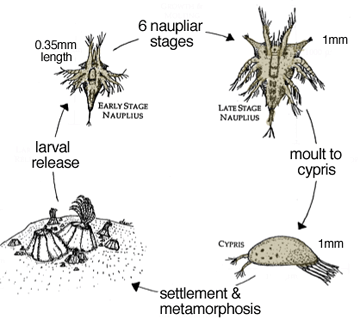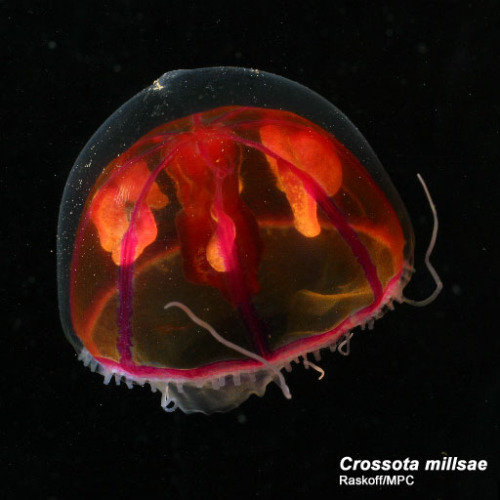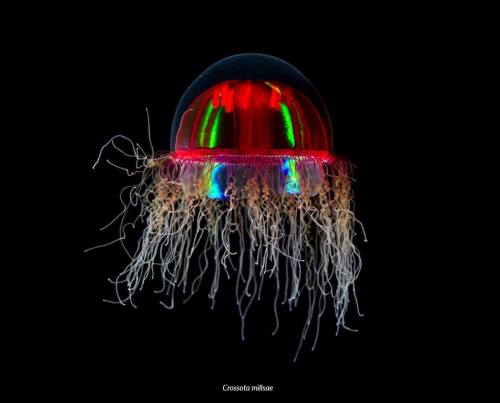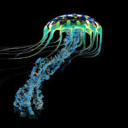Sea Angel

Sea Angel
Cliopsis krohni
The Sea Angel is a tiny snail that is only 4 cm in length and found at depths as deep as 1500 m. Even though it is small, it is a viscous predator. It hunts other midwater snails using a structure called a radula. Unlike other snails, the Sea Angel’s mouth is located on top of its head. It also uses swimming “wings” to propel through the water.
Photo Source: http://seaslugsofhawaii.com/species/Cliopsis-krohni-a.html
More Posts from Bioluminescentoceangoddess and Others
If you are interested in learning about different types of plankton in the ocean, please check out @planktonqueen page. I post a lot of cool species, photos, and facts.


Barnacle Larvae
Amphibalanus eburneus
When we think of barnacles, we think of the hard, white crustaceans that grow on the side of boats and docks. However, barnacles go through a variety life stages and metamorphosis before they spend their life on a hard surface. The image above is a barnacle larvae when it is in the cypris stage, think of it as a baby barnacle. This larvae is an example of zooplankton and spends a short period of time floating around in the water column. The second image summarizes the life cycle of a barnacle.
Photo source: https://www.nyharbornature.com/blog/barnacles-are-reproducing
https://www.pinterest.com/pin/453174781229895797/

Hula Skirt Siphonophore
Physophora hydrostatica
The Hula Skirt Siphonophore a deep sea siphonophore that is found between 700 m to 1000m. It is made of a colony of hundreds tiny zooids. The top portion of the colony holds the swimming bells, which allow the colony to move. The bottom of the siphonophore holds the orange ‘hula skirt,’ which is full of stinging tentacles.
Photo link : https://twitter.com/montereyaq/status/1162068535331311617?lang=da


Pigbutt worm
Chaetopterus pugaporcinus
The Pigbutt worm or the flying buttocks of the sea is spotted floating between 965 m to 1300 m in the deep ocean. It is actually a polychaete (polly-keet) worm species that burrows in the ground as an adult, and floats around the ocean as a baby. The worm feeds itself : by creating a balloon of mucus; collecting particles on the mucus; and then consuming the particles. It is the rarest and thickest worm in the deep ocean, for only ten have been spotted.
Photocredit: https://roaring.earth/pigbutt-worm/





Wake up babe new fish dropped
Sea sparkle is a common, bioluminescent plankton. Even though its not an animal, it is worth sharing.


Sea sparkle
Noctiluca scintillans
Sea sparkle is a bioluminescent dinoflagellate that blooms in many coastal waters. Sea sparkle feeds on plankton, diatoms, fish eggs, and other dinoflagellates. It also has a flagellum, or tiny tail, that helps it move around in the water. Even though sea sparkle is beautiful to witness at night, it is hazardous to other marine species and resembles a reddish-pink film during the day.
Photo credit:
https://alexandrathemb.tumblr.com/post/49814932878/noctilucas-scintillans-a-bioluminescent
https://thevelv.blogspot.com/2015/07/noctiluca-scintillans.html


Helmet Jelly
Periphylla periphylla
The Helmet Jelly can be found at all depths of the ocean. This vibrant and strange jellyfish tends to proliferate in Norwegian fjords. They are one of the dominant predators in these isolated ecosystems.
Photos
http://www.seawater.no/fauna/cnidaria/periphylla.html
https://www.bigfishexpeditions.com/2019/01/24/norway-deepwater-shark-diving-2018/helmet-jelly/


Pink Helmet
Aglantha digitale
The Pink Helmet is a mini hydromedusa that comes in a variety of vibrant colors. The tiny jelly is only 4 cm in size and is found towards the surface of the ocean. The purple and blue hues we see in its bell are caused by a phenomenon known as iridescence, when light strikes the jelly’s thin tissue at different angles (similar to what we see in a soap bubbles). It also has orange pigmentation near its mouth; this pigmentation helps attract prey and mask luminescence. Furthermore, females tend to be more colorful than males.
Photo credit: https://biolum.eemb.ucsb.edu/organism/pictures/aglantha.html
https://www.pinterest.com/pin/186899453255850798/

Glass Octopus
Vitreledonella richardi
The Glass Octopus spend its entire life in the midwater section of the ocean and found at depths between 200m to 2000m. Even though it has no protection from predators, it achieves perfect transparency. The only part of the Glass Octopus that is visible is its digestive gland. However, the digestive gland is placed vertically to minimize detection. In addition, I find this octopus to be super cute!
Photo credit: https://www.mynumer.com/forums/topic/499/invisible-animals/view/post_id/859


Psychedelic Medusa
Crossota millsae
The Psychedelic Medusa is a deep-sea hydrozoan that is abundant in the North Pacific. The mini-jelly is found at depths between 1000m to 3800m, and are often observed drifting near the ocean floor. It also has an eccentric reproduction behavior uncommon in cnidarians. The females display viviparity, and carry the babies in her bell until they are ready to hatch.
Photo credit: http://www.arcodiv.org/watercolumn/cnidarian/Crossota_millsae.html
https://twitter.com/spothvegr/status/1030177493075079169


Googly-eyed glass squid
Teuthowenia pellucida
The Googly eyed squid is a rare oddity that is found in the southern hemisphere. It has a large, spherical head that is filled with water and teeny, tiny tentacles that help propel it through the water. If it comes across a predator, it deflates its head and draws its tentacles into its cavity. On the other hand, it may also fill the cavity with water to increase its size, and intimidate the predator. If all fails, it will ink and try to escape through the darkness. Furthermore, baby squids can be found at the surface (0-600m); then slowly migrate downwards as they mature into adults (1600-2500m).
Photo credit: http://animaladay.blogspot.com/2011/07/googly-eyed-glass-squid.html
https://faunafabula.tumblr.com/post/5999675353/googly-eyed-glass-squid-teuthowenia-pellucida
-
 mycellpics liked this · 1 year ago
mycellpics liked this · 1 year ago -
 low-level--00 reblogged this · 2 years ago
low-level--00 reblogged this · 2 years ago -
 low-level--00 liked this · 2 years ago
low-level--00 liked this · 2 years ago -
 enigmaticenergite reblogged this · 3 years ago
enigmaticenergite reblogged this · 3 years ago -
 rainwrapped liked this · 3 years ago
rainwrapped liked this · 3 years ago -
 nejniy-pulse liked this · 3 years ago
nejniy-pulse liked this · 3 years ago -
 despair-with-walnuts liked this · 3 years ago
despair-with-walnuts liked this · 3 years ago -
 mistbunny liked this · 3 years ago
mistbunny liked this · 3 years ago -
 creaturedeityendless liked this · 3 years ago
creaturedeityendless liked this · 3 years ago -
 deadlygoldfish22 liked this · 3 years ago
deadlygoldfish22 liked this · 3 years ago -
 vaguelyexistingcloud liked this · 3 years ago
vaguelyexistingcloud liked this · 3 years ago -
 sweet-sea-monster reblogged this · 3 years ago
sweet-sea-monster reblogged this · 3 years ago -
 cursedd-plazzer liked this · 3 years ago
cursedd-plazzer liked this · 3 years ago -
 salvagethevixin liked this · 3 years ago
salvagethevixin liked this · 3 years ago -
 ghost-in-a-wasteland liked this · 4 years ago
ghost-in-a-wasteland liked this · 4 years ago -
 dimens1ons liked this · 4 years ago
dimens1ons liked this · 4 years ago -
 lilskysparrow liked this · 4 years ago
lilskysparrow liked this · 4 years ago -
 alux-ulkan liked this · 4 years ago
alux-ulkan liked this · 4 years ago -
 that-lesbian-phenotype liked this · 4 years ago
that-lesbian-phenotype liked this · 4 years ago -
 stevia333k-naturepics reblogged this · 4 years ago
stevia333k-naturepics reblogged this · 4 years ago -
 myartrefblog reblogged this · 4 years ago
myartrefblog reblogged this · 4 years ago -
 rabbitsartcorner liked this · 4 years ago
rabbitsartcorner liked this · 4 years ago -
 disableddeinosaur liked this · 4 years ago
disableddeinosaur liked this · 4 years ago -
 digigal-transbian liked this · 4 years ago
digigal-transbian liked this · 4 years ago -
 ailinenelpaisdelasmaravillas liked this · 4 years ago
ailinenelpaisdelasmaravillas liked this · 4 years ago -
 stevia333k liked this · 4 years ago
stevia333k liked this · 4 years ago -
 dgm56 liked this · 4 years ago
dgm56 liked this · 4 years ago -
 strangelightspyweasel liked this · 4 years ago
strangelightspyweasel liked this · 4 years ago -
 punkrock-furiosa liked this · 4 years ago
punkrock-furiosa liked this · 4 years ago -
 isac24r liked this · 4 years ago
isac24r liked this · 4 years ago -
 babiicutthroatt reblogged this · 4 years ago
babiicutthroatt reblogged this · 4 years ago -
 vulcanupthatbitch reblogged this · 4 years ago
vulcanupthatbitch reblogged this · 4 years ago -
 sammimantha reblogged this · 4 years ago
sammimantha reblogged this · 4 years ago -
 sammimantha liked this · 4 years ago
sammimantha liked this · 4 years ago -
 worldofwhales liked this · 4 years ago
worldofwhales liked this · 4 years ago -
 katacala reblogged this · 4 years ago
katacala reblogged this · 4 years ago -
 stan-the--man liked this · 4 years ago
stan-the--man liked this · 4 years ago -
 crypticreatures reblogged this · 4 years ago
crypticreatures reblogged this · 4 years ago -
 fangs-4-fags reblogged this · 4 years ago
fangs-4-fags reblogged this · 4 years ago -
 the-ping-reach liked this · 4 years ago
the-ping-reach liked this · 4 years ago -
 impossibleeagleturtle liked this · 4 years ago
impossibleeagleturtle liked this · 4 years ago -
 sharks-house reblogged this · 4 years ago
sharks-house reblogged this · 4 years ago -
 cancerianfelid liked this · 4 years ago
cancerianfelid liked this · 4 years ago -
 bardofthebored liked this · 4 years ago
bardofthebored liked this · 4 years ago

Bioluminescence is a chemical reaction that produces light. Many deep sea animals use bioluminescence. This blog is dedicated to educating the public about the amazing creatures that thrive in the deep sea.
57 posts